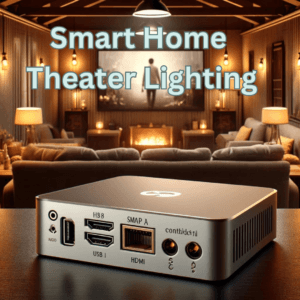Why Is Smart Home Theater Lighting Important?
Imagine this: Your popcorn’s ready, and the sound system is spot-on. The screen? Sharp as ever. But, oh no, the room’s lighting is way off. It’s like trying to enjoy a summer flick with too much sunshine. Annoying, huh? In a home theater, lighting is key. Nail it, and you’ve got a little slice of magic. Mess it up, and even the fanciest gear won’t cut it.
I’m here to show you how to nail that movie magic, with a tech twist. Think of a mini PC not just as a workhorse for office stuff but as the boss of your lighting. It’s small but mighty, able to control every light to match your mood. And when it comes to smart home theaters, this is next-level cool.
You’ll learn how to use ambient light to set the chill vibe, task lighting to light up the right spots, and accent lights to show off your room’s style. Best part? A mini PC can handle it all. It’s like the conductor of an orchestra, ready to turn your smart home theater lighting into a perfect visual symphony. Let’s get to it!
Key Takeaways
- Proper lighting is crucial for creating the right home theater experience.
- Mini PCs can be the central control for smart home theater lighting.
- Ambient, task, and accent lighting all play unique roles in enhancing the viewing experience.
- Smart bulbs and mini PCs offer customizable, energy-efficient lighting options.
The Smart Home Theater Lighting Ensemble
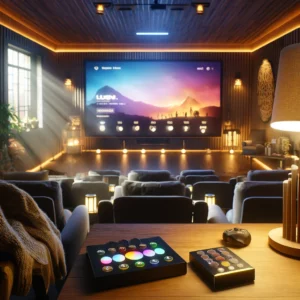
I’m going to talk about three stars of the show in the smart home theater lighting world: ambient, task, and accent lighting. Each of these plays a unique role in creating your personal cinema paradise.
Ambient Lighting
Ambient lighting is like the base coat of paint on a canvas; it sets the general brightness of your room without stealing the spotlight. Think of it as the overall glow that lets you navigate without tripping over the popcorn bowl.
Task Lighting
Next in line is task lighting. This isn’t just about brightening up the room; it’s about functionality. You’re going to want to see your remote, your snacks, and maybe even your guest’s face as they jump during a thriller movie scene. Task lighting is specifically positioned and directed for these activities, without interfering with your viewing experience.
Accent Lighting
Lastly, there’s accent lighting, and that’s where the magic happens. Accent lighting adds depth and drama. It highlights your collection of film memorabilia, sculpts the room’s architecture, or simply accentuates the walking path. It’s these subtle touches that can transport you from your living room to the center of an action sequence or the heart of a romantic encounter.
Put these all together with a Mini PC
Now, imagine managing this trio effortlessly with the touch of a button. That’s where the mini PCs come into play. You can always adjust your approach down the road, but mini PCs are designed to integrate with smart home applications, giving you the power to orchestrate ambient, task, and accent lighting to perfection. Whether it’s setting scenes, adjusting brightness, or scheduling changes, a mini PC can do so much more than just stream your favorite flicks. It can conduct and direct your smart home theater lighting to make things dance off the screen!
Illuminate Intelligently: The Smart Lighting Revolution
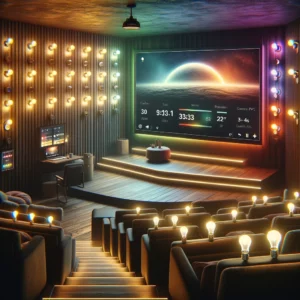
Smart home technology has paved the way for a lighting revolution that’s smart, intuitive, and incredibly customizable. Imagine being able to adjust your smart home theater lighting without ever leaving your seat, responding to the mood of the movie with just a few taps on your smartphone or a spoken command.
Using Smart Bulbs to Paint a Picture
At the forefront of this revolution are smart bulbs, which are capable of being dimmed, timed, and even color-changed remotely. This isn’t just about convenience; it’s also about creating the right ambiance for your viewing pleasure. When it’s time for a suspenseful scene, dim the lights to match the tension, or bask your room in a soft blue hue for a serene documentary—choices are at your fingertips.
Weave the Bulbs Together with Smart Home Platforms
But smart bulbs are part of a larger ecosystem. Mini PCs become the maestros of this system, thanks to their ability to interface with various smart home platforms. With a compact yet powerful mini PC at the helm, you can integrate lighting controls within a broader smart home setup, orchestrating every luminary element from one central point.
What’s more, through apps and home automation software running on a mini PC, you have the power to create scenes and schedules. Say you’re planning a movie marathon; with a few clicks, you can design a lighting scene that slowly dims as the evening progresses, enhancing the cinematic feel as the stars come out.
A well-integrated mini PC lets you take advantage of these smart functions and ties them seamlessly into the next logical step: energy efficiency. That’s going to include looking at how these smart systems don’t just excite the senses but also save on the utility bill by intelligently managing energy consumption.
Stay tuned because I’m going to help you navigate energy-efficient options next. This will ensure you’re equipped not just for a stunning visual display, but also for an eco-friendly, cost-effective entertainment hub.
Green Illumination: Sustainable and Efficient Lighting
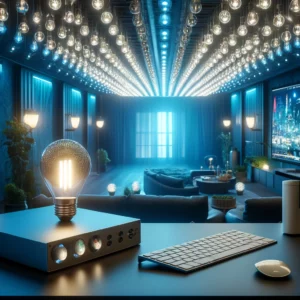
You’re likely already conscious of your energy consumption, and when it comes to home theaters, there’s a secret star – LED bulbs. These are not only kind to your wallet over time, but they also offer a brilliant range of lighting options without the heat emission associated with traditional bulbs.
Opting for LED technology means you’re choosing bulbs with a longer lifespan, which translates into less frequent replacements. That’s going to include savings in both cost and effort. And it’s not just about longevity; LED bulbs give you the brightness and color control necessary for a truly immersive viewing experience.
LEDs with Mini PCs will Save Energy Through Automation
Now, pair these LEDs with a mini PC, and you’ve got an intelligent setup that takes your lighting to the next level. A mini PC can automatically adjust lighting based on the content on screen or the time of day. Meeting scenes can be sharp and bright, while nighttime action can be backed with subtle, automated dimness for a more theater-like feel.
Automation isn’t just about cool moments during your favorite films. It means your mini PC can turn off lights when the room’s not in use, or adjust brightness levels to conserve energy during daylight hours. That’s practical tech working for you.
If you’re ready to take the next step in lighting sophistication, then hang tight. I’m going to help you with advice on how you can tweak these setup elements for maximum effect. That’s right, we’re moving into the realm of design: strategic use of dimmers, circumventing annoying screen reflections, and the underestimated power of blackout curtains. And yes, more on how your trusty mini PC becomes the maestro of this orchestration.
Designing the Glow: Lighting Tips for an Immersive Experience
Getting the ambiance just right in your home theater goes beyond flipping a switch. Lighting plays a pivotal role in creating an environment that’s both functional and theatrical. And when you couple savvy design with the precision of a mini PC, you transform a mere viewing area into an immersive cinematic retreat.
Dimmers act to Make Colors Stand Out or Stand Back
Dimmers are your first golden ticket to versatility. They allow you to tweak light levels to match the mood of your movie without a hitch. I’m going to show you how the strategic placement of these dimmers, controlled by your mini PC, can mimic the soft fade-out of lights you’d experience in a commercial theater.
Avoid Screen Reflections
Screen reflections can be the arch-nemesis of clear visibility. So what’s the solution? It’s all about the angle and source placement of your lighting. Avoiding direct beams on your screen is key, and mini PCs can help by automating the adjustment of lights based on the content playing or the time of day.
How Can Blackout Curtains Help?
Let’s talk about the use of blackout curtains or shades. These are non-negotiable for daytime viewers. Blackout solutions block external light, bringing out the true depth and color of your screen. Hook these up to a mini PC, and you can have curtains that close with the start of your show, just like in a professional theater.
Your mini PC isn’t just about on and off settings; it’s about coordination. With its help, you can integrate these elements into a responsive system that enhances your viewing experience dramatically. The right lighting setup can take you from a mundane room to a space where every showing is a premiere.
Connecting your Mini PC to the Lights: Software Applications
You can install home automation software on either Windows or Ubuntu. Here I will mention two, but there are others.
Home Assistant
Home Assistant is free and open-source software for home automation, designed to be an Internet of things (IoT) ecosystem-independent integration platform and central control system for smart home devices, with a focus on local control and privacy.
Home assistance can be installed on both Ubuntu and Windows. It allows you to integrate and control smart home devices, including lighting systems, from a single dashboard. For Ubuntu, you can install Home Assistant directly and even set up motion-activated light automation. For Windows, you can follow specific guides to install Home Assistant as detailed in YouTube tutorials.
Cortana
On Windows, you can use Cortana to control smart home devices including lights. Cortana is not only Windows voice app, it can integrate with devices that allow you to adjust your lights via voice commands, provided your devices are compatible and connected through the appropriate services.
Both solutions offer robust control over your home automation needs and can be tailored to a wide range of user preferences and technical skill levels.
Setting the Mood: Evocative Lighting for Every Genre
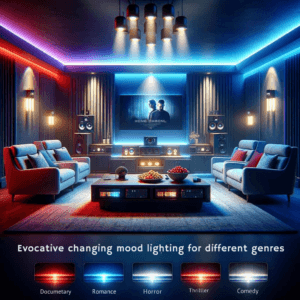
Have you ever noticed how lighting in a movie can completely transform the scene? It’s the same with your home theater. Color-changing LEDs and backlights aren’t just fancy gadgets; they’re the paintbrushes of your viewing room. With these tools, mini PCs become the artist, turning your room into an extension of the film’s world through vibrant hues and tones.
Color Changing LEDs
Imagine watching a serene underwater documentary. Your mini PC can sync the lighting to emit a gentle blue glow. Now switch to an intense thriller, and it automatically shifts to stark whites and reds. This isn’t just about personal preference; it’s about creating an immersive experience that aligns with the story onscreen.
Lighting Presets
Leverage the power of mini PCs to set lighting presets corresponding to different movie genres or even specific films. Want a cozy, warm light for romantic comedies? Or cool, eerie tones for science fiction? Your mini PC, interacting with your smart lighting system, can make these transitions effortless.
Now, why stop at movies? If you’re a gaming fan, lighting can signal in-game status updates or changes in gaming environments. This dynamic shift adds a layer of interactivity and excitement to your experience that traditional setups can’t offer.
You’re heading towards a world where the lighting does more than simply illuminate; it resonates with the content, enhancing mood, and elevating your engagement. With mini PC integration, the variations are just limited by your imagination. Remember, the right ambiance is vital for those memorable movie nights, it’s what takes your viewing from good to great.
Encore: Why Your Home Theater Needs a Mini PC Lighting Director
I’m going to wrap up with why the use of mini PCs in your home theater isn’t just a fancy add-on, it’s a game-changer. A mini PC acts as the conductor of your lighting orchestra, brilliantly managing every aspect to ensure your visual and emotional experience is second to none.
You’ve seen how these compact powerhouses can handle your ambient, task, and accent lighting needs with finesse, syncing with smart bulbs to bring your room to life or down to a cozy dim with the touch of a button.
Energy efficiency is something we can’t overlook today. Mini PCs stretch this concept in your home theater by intelligently learning your habits and preferences, automating your lighting to save on those bills without you lifting a finger.
In my opinion, the magic really kicks in with the mood enhancement. Choosing your scene with color-changing LEDs and preset moods, the mini PC allows you to immerse fully in the action, romance, or horror of your screen, making each night a premiere at your home.
I really hope that you see the brilliance of integrating mini PCs into your home theater lighting setup. It’s your turn to take the reins of technology and steer your viewing experience into the future. Your first attempt at setting it up doesn’t need to be your last, but it’s a step toward achieving a cinema-quality environment at home. Want to make every movie night legendary? Consider a mini PC the key ingredient to your ultimate home theater.
Frequently Asked Questions
What is smart home theater lighting?
Smart home theater lighting refers to a customizable and controllable lighting system that enhances the viewing experience in a home theater. It often includes features like dimming, color changing, and synchronization with audio-visual content, all manageable via devices such as mini PCs.
How does a mini PC control home theater lighting?
A mini PC can control home theater lighting through smart home applications, allowing users to adjust settings such as brightness, color, and scenes. The mini PC acts as a hub that communicates with smart lighting fixtures via wireless signals.
Can smart home theater lighting save energy?
Yes, smart lighting often includes LED bulbs which are more energy-efficient than traditional bulbs. Plus, automation features like dimming and scheduling can further reduce electricity usage.
What are the types of lighting used in a smart home theater setup?
Ambient lighting: Provides the overall illumination of the space.
Task lighting: Focuses light for specific tasks, like reading or navigating.
Accent lighting: Highlights architectural features or decorations.
Do I need a professional to install smart home theater lighting?
It depends on the complexity of your system. Simple setups with plug-and-play devices can be DIY projects, but for integrated systems, professional installation might be advisable.
Can I control smart home theater lighting with my phone?
Yes, most smart home theater lighting systems can be controlled with a smartphone app, allowing you to adjust settings from your seat.

I am a retired software engineer with experience in a multitude of areas including managing AWS and VMWare development environments. I bought a relative a mini-PC a year ago and have become passionate about the technology and its potential to change how we deploy software.

